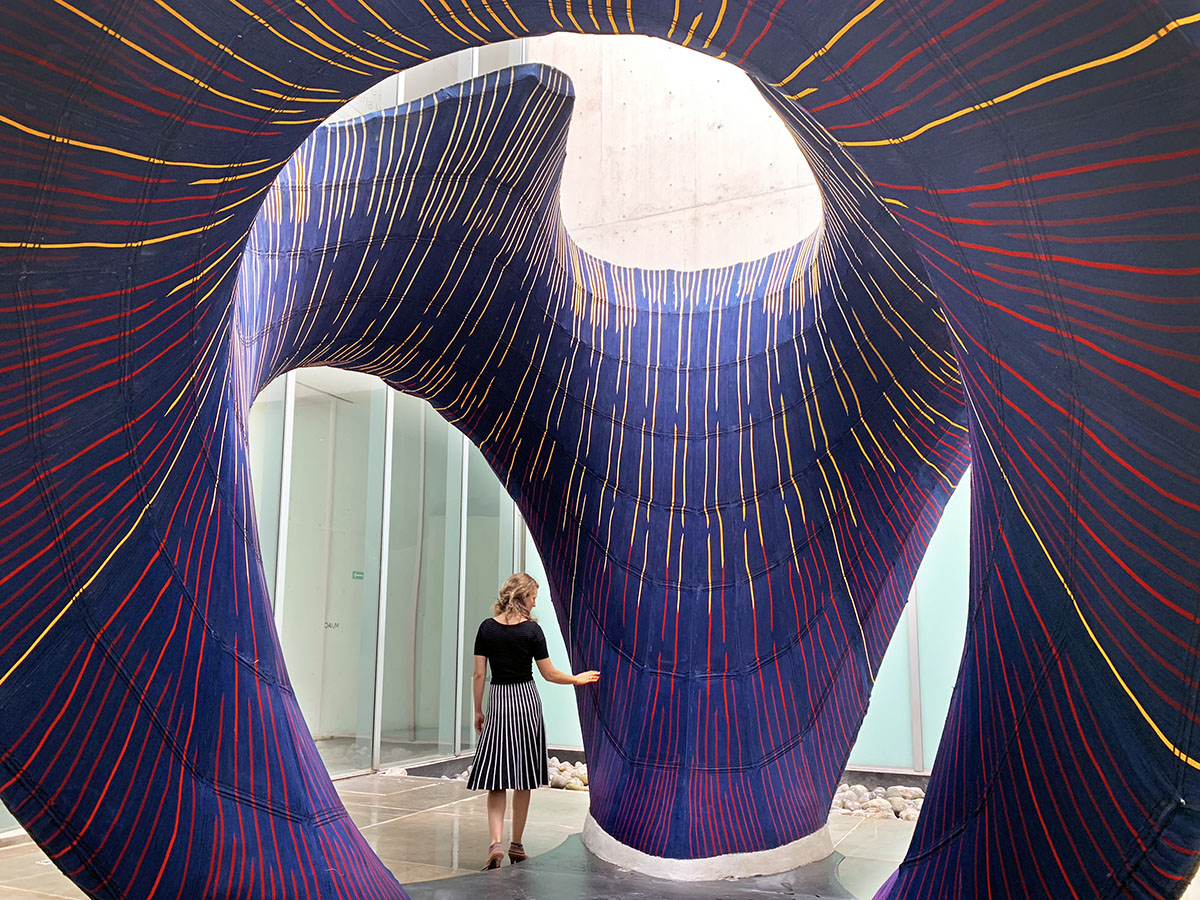Submitted by WA Contents
Zaha Hadid Architects designed a sinuous concrete shell for its first exhibition in Mexico
Mexico Architecture News - Nov 01, 2018 - 08:24 20322 views

Zaha Hadid Architects has designed an experimental structure that pays homage to the Spanish-Mexican architect and engineer Félix Candela.
Made up of a thin, sinuous concrete shell built on ultra-lightweight knitted formwork, it was constructed at the Museo Universitario Arte Contemporáneo (MUAC) in Mexico City as part of Zaha Hadid Architects’ first exhibition in Latin America.
Video courtesy of ZHA

Image © Juan Pablo Allegre
Inspired by the fluid forms of the colourful traditional dress of Jalisco, Mexico, the installation - called KnitCandela - reimagines his inventive concrete shell structures through the introduction of new computational design methods and innovative KnitCrete formwork technology.
KnitCandela features a dynamic geometry with internal colorful stripes surrounding the structure. While the structure’s local builders nicknamed the project 'sarape' (a striped scarf that originated in Mexico), KnitCandela’s form references his acclaimed restaurant at Xochimilco; a concept he further developed in several of his subsequent projects.

Image © Juan Pablo Allegre
While Candela relied on combining hyperbolic paraboloid surfaces (“hypars”) to produce reusable formworks leading to a reduction of construction waste, KnitCrete allows for the realisation of a much wider range of anticlastic geometries.
With this cable-net and fabric formwork system, expressive, freeform concrete surfaces can now be constructed efficiently, without the need for complex moulds.

Image © Philippe Block
KnitCandela’s thin, double-curved concrete shell with a surface area of almost 50 sq.m. and weighing more than 5 tonnes, was applied on a KnitCrete formwork of only 55 kg. The knitted fabric of the formwork system was carried to Mexico from Switzerland in a suitcase.

Image © Philippe Block

Image © Mariana Popescu

Image © Leo Bieling

KnitCandela detailed construction drawing

KnitCandela Elevation

KnitCandela plan

KnitCandela section
KnitCandela Fact sheet
- Global dimensions shell: 5.8m x 5.8m x 4.1m
- Surface area of concrete: 47.5 sq.m.
- Weight concrete: 5 tonnes
- Weight formwork: 30 kg (cable net) + 25 kg (knit)
- Total length yarn: 350 km
- Type of yarn: Polyester (PES)
- Total amount of loops: 14’660’028
- Knitting time: 36 hours
- Modelling balloons used: 1000
Project Team
Block Research Group, ETH Zurich (BRG)
Zaha Hadid Computation and Design Group (ZHCODE)
Architecture Extrapolated (R-EX)
Design
Zaha Hadid Architects: Patrik Schumacher, Principal
ZHCODE: Filippo Nassetti, Marko Margeta, David Reeves, Shajay Bhooshan
BRG: Mariana Popescu, Matthias Rippmann, Tom Van Mele, Philippe Block
KnitCrete technology
BRG: Mariana Popescu, Tom Van Mele, Philippe Block
Chair of Physical Chemistry of Building Materials, ETH Zurich: Lex Reiter, Robert Flatt
Fabrication and construction
BRG: Mariana Popescu, Matthias Rippmann, Alessandro Dell’Endice, Cristian Calvo Barentin, Nora Ravanidou
R-EX: Horacio Bibiano Vargas, Jose Manuel Diaz Sanchez, Asunción Zúñiga, Agustín Lozano Álvarez, Miguel Juárez Antonio, Filiberto Juárez Antonio, Daniel Piña, Daniel Celin, Carlos Axel Pérez Cano, José Luis Naranjo Olivares, Everardo Hernández, Ramiro Tena, Alicia Nahmad Vazquez.
Structural engineering
BRG: Andrew Liew, Tom Van Mele
Concrete development
Holcim Mexico: Jose Alfredo Rodriguez, Carlos Eduardo Juarez, Delia Peregrina Rizo
Site construction coordination
R-EX: Alicia Nahmad Vazquez
Exhibition content, coordination, and curation
Zaha Hadid Exhibitions and Archives: Jillian Nishi, Margaratia Valova, Daria Zolotareva, Paz Bodelon, Elena Castaldi, Manon Janssens, Woody Yao
ZHCODE: Leo Bieling, Federico Borello, Filippo Nassetti, Marko Margeta, Henry David Louth, Shajay Bhooshan
BRG: Mariana Popescu, Matthias Rippmann, Noelle Paulson, Philippe Block
Sponsors: COMEX, NCCR Digital Fabrication, ETH Zurich, Zaha Hadid Architects, Steiger Participations SA, Holcim Mexico, Imerys Aluminates, Boston Consulting Group
Special thanks: Grupo Altiva, UNAM Arquitectura
Top image © Philippe Block
All drawings © ZHA
> via ZHA
